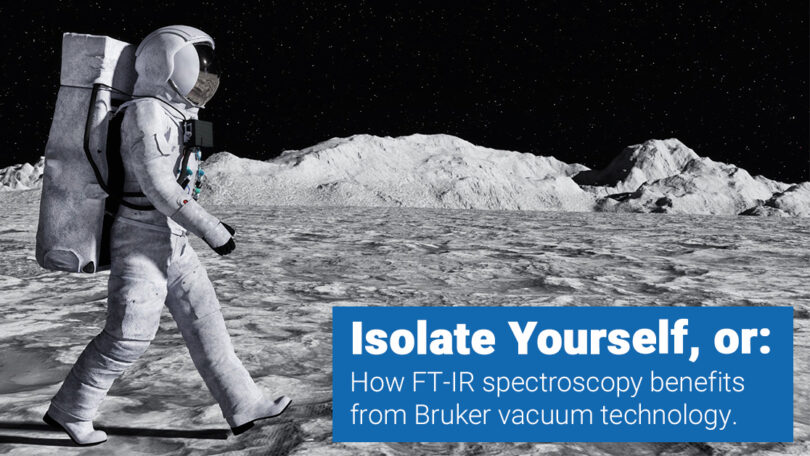How FT-IR spectroscopy benefits from Bruker vacuum technology
FT-IR Spectroscopy is based on interaction of molecular bonds with light. Covalent, ligand or even intermolecular bonds can be excited and absorb specific frequencies of the incoming IR light. When we analyze the characteristic absorption band position, intensity and how this depends on temperature, time etc., we can identify and quantify substances, monitor reactions, and understand complex processes. Depending on application field, the requirements for e.g. instrumental sensitivity (SNR), accuracy, spectral range, temporal resolution can be very different.
For most routine analysis tasks, the sample amount is big and absorption bands are rather strong. However, when it comes to experiments where only tiny sample amount is available, or absorption coefficients of the relevant absorption bands are pretty low, high instrumental performance becomes more crucial. In FT-IR spectroscopy atmospheric disturbance is a known limitation. Moisture (H2O) and CO2 in ambient air are strong IR absorbers and both have intense bands in the MIR region (4000 – 400 cm-1). In the far IR region, atmospheric absorption becomes stronger, even leading to total absorption in parts of the range < 400 cm-1. These disturbances can cover spectral sample features and strongly limit analytical insight and data evaluation.

The most common method to reduce the atmospheric contamination is to purge the optics bench with dry air or N2. By keeping water vapor and CO2 content constant, the contamination bands in the resulting difference spectrum can be suppressed. However, even “dry” purge air contains residual moisture and CO2, and its supply can fluctuate (e.g. by temperature, purity, and pressure fluctuations), still causing significant residual artifacts. Another approach to reduce atmospheric contamination are sealed spectrometers with desiccant inside. But this is even less effective and rather limited to routine analysis purposes. In advanced and high-end research applications, also improved purge quality or post data manipulations are applied to suppress water and CO2 bands. However, all the above methods do not avoid the influence of water and CO2 absorption, but just reduce it, while the result spectrum still bears its trace. Atmospheric absorption still takes place, implying reduced throughput and signal to noise ratio, plus possible artifacts in the sample spectrum. In particular for demanding R&D measurements in mid and far IR it can therefore be difficult or even impossible to obtain adequate results. Therefore, a better solution is necessary!

Bruker always strives to catalyze innovation and support pioneering researchers. For this demand, Bruker is famous, since already its first research spectrometers in the early 1970s provided the ideal answer to avoid atmospheric artifacts by completely evacuating the optical bench. During the following 3 generations, technology, performance and usability of vacuum FT-IR spectrometers have been continuously pushed forward and the current VERTEX vacuum series is world-wide accepted, including the VERTEX 80v as the high-end FT-IR gold standard. This peak performance statement is true in regards of sensitivity, spectral & temporal resolution, spectral range & resolution, flexibility, stability, accuracy and upgradability. The VERTEX vacuum series is the culmination of Bruker’s knowledge and experience over 50 years. The cast aluminum housing and vacuum compatible components enable evacuation of the complete beam path down to a few mbar, where contributions of water or CO2 become negligible. This is a unique benefit for various applications, such as FIR spectroscopy, measurements of ultra-thin films or similar samples with extremely low sample amount, reflection absorption or DRIFT experiments with low signal throughput, emission spectroscopy, Step Scan spectroscopy and any measurement where weak absorption bands are expected in regions, which are masked by water vapor or CO2 absorption.

Furthermore, the vacuum benefit is not limited to elimination of atmospheric disturbance, but includes much more benefits:
- No temperature fluctuation influenced by environment
- No atmospheric absorbance interfering with high spectral resolution features
- No problems caused by fluctuation of the dry air purge supply
- Highest stability and reproducibility
- Utmost sensitivity
FT-IR spectroscopy under vacuum opens the door to dedicated, highly demanding applications. Experiments which are impossible under ambient conditions are feasible with vacuum spectrometers. In further blog articles we will highlight by dedicated application examples, how you can isolate your sample from the atmosphere and stand out from environmental interferences.








